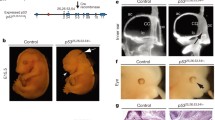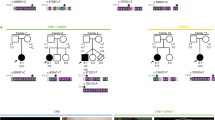Abstract
CHD7 is a novel chromodomain gene mutated in 60%–80% of humans with CHARGE syndrome, a multiple congenital anomaly condition characterized by ocular coloboma, heart defects, atresia of the choanae, retarded growth and development, genital hypoplasia, and characteristic ear abnormalities including deafness. Phenotypic features of CHARGE are highly variable and incompletely penetrant. To explore developmental roles of CHD7, we generated mice carrying the Chd7Gt allele from a Chd7-deficient, gene-trapped lacZ reporter ES cell line. RT-PCR of embryo RNA demonstrated significantly reduced levels of wild-type transcript in Chd7Gt/Gt embryos. Chd7Gt/Gt embryos survive only up to embryonic day 10.5 (E10.5). Chd7Gt/+ male and female mice are viable, small, and exhibit variable degrees of head-bobbing and circling, consistent with vestibular dysfunction. Paint-filling of E16.5 heterozygous inner ears revealed defects of the semicircular canals. The pattern of β-galactosidase activity in Chd7Gt/+ embryos mimics Chd7 mRNA expression in wild-type embryos, confirming the fidelity of the lacZ reporter. We observed tissue-specific β-galactosidase in the E12.5 and E14.5 Chd7Gt/+ brain, pituitary, ear, heart, and craniofacial structures, indicating survival of Chd7Gt/+ cells in CHARGE-relevant organs. These studies demonstrate the utility of Chd7Gt as a reporter-tagged loss-of-function allele for future studies exploring developmental mechanisms of Chd7 deficiency.







Similar content being viewed by others
References
Alavizadeh A, Kiernan AE, Nolan P, Lo C, Steel KP, et al. (2001) The Wheels mutation in the mouse causes vascular, hindbrain, and inner ear defects. Dev Biol 234(1), 244–260
Aramaki M, Udaka T, Kosaki R, Makita Y, Okamoto N, et al. (2006) Phenotypic spectrum of CHARGE syndrome with CHD7 mutations. J Pediatr 148(3), 410–414
Becker PB, Hörz W (2002) ATP-dependent nucleosome remodeling. Annu Rev Biochem 71, 247–273
Bosman EA, Penn AC, Ambrose JC, Kettleborough R, Stemple DL, et al. (2005) Multiple mutations in mouse Chd7 provide models for CHARGE syndrome. Hum Mol Genet 14(22), 3463–3476
Boyer LA, Latek RR, Peterson CL (2004) The SANT domain: a unique histone-tail-binding module? Nat Rev Mol Cell Biol 5(2), 158–163
Chen WV, Soriano P (2003) Gene trap mutagenesis in embryonic stem cells. Methods Enzymol 365, 367–386
Chen WV, Delrow J, Corrin PD, Frazier JP, Soriano P (2004) Identification and validation of PDGF transcriptional targets by microarray-coupled gene-trap mutagenesis. Nat Genet 36(3), 304–312
Copp AJ (1995) Death before birth: clues from gene knockouts and mutations. Trends Genet 11(3), 87–93
Daubresse G, Deuring R, Moore L, Papoulas O, Zakrajsek I, et al. (1999) The Drosophila kismet gene is related to chromatin-remodeling factors and is required for both segmentation and segment identity. Development 126(6), 1175–1187
Doerks T, Copley RR, Schultz J, Ponting CP, Bork P (2002) Systematic identification of novel protein domain families associated with nuclear functions. Genome Res 12(1), 47–56
Eberharter A, Becker PB (2004) ATP-dependent nucleosome remodelling: factors and functions. J Cell Sci 117(Pt 17), 3707–3711
Friedrich G, Soriano P (1993) Insertional mutagenesis by retroviruses and promoter traps in embryonic stem cells. Methods Enzymol 225, 681–701
Gage PJ, Suh H, Camper SA (1999) Dosage requirement of Pitx2 for development of multiple organs. Development 126(20), 4643–4651
Hall BD (1979) Choanal atresia and associated multiple anomalies. J Pediatr 95(3), 395–398
Harris J, Robert E, Kallen B (1997) Epidemiology of choanal atresia with special reference to the CHARGE association. Pediatrics 99(3), 363–367
Hawker K, Fuchs H, Angelis MH, Steel KP (2005) Two new mouse mutants with vestibular defects that map to the highly mutable locus on chromosome 4. Int J Audiol 44(3), 171–177
Issekutz KA, Graham JM Jr, Prasad C, Smith IM, Blake KD (2005) An epidemiological analysis of CHARGE syndrome: preliminary results from a Canadian study. Am J Med Genet A 133(3), 309–317
Jackler RK, Luxford WM, House WF (1987) Congenital malformations of the inner ear: a classification based on embryogenesis. Laryngoscope 97(3 Pt 2 Suppl 40), 2–14
Jongmans M, Admiraal R, van der Donk K, Vissers L, Baas A, et al. (2006) CHARGE syndrome: the phenotypic spectrum of mutations in the CHD7 gene. J Med Genet 43(4), 306–314
Kallen K, Robert E, Mastroiacovo P, Castilla EE, Kallen B (1999) CHARGE association in newborns: a registry-based study. Teratology 60 (6), 334–343
Khadilkar VV, Cameron FJ, Stanhope R (1999) Growth failure and pituitary function in CHARGE and VATER associations. Arch Dis Child 80 (2), 167–170
Kiernan AE, Erven A, Voegeling S, Peters J, Nolan P, et al. (2002) ENU mutagenesis reveals a highly mutable locus on mouse Chromosome 4 that affects ear morphogenesis. Mamm Genome 13(3), 142–148
Kim DG, Kang HM, Jang SK, Shin HS (1992) Construction of a bifunctional mRNA in the mouse by using the internal ribosomal entry site of the encephalomyocarditis virus. Mol Cell Biol 12 (8), 3636–3643
Lalani SR, Safiullah AM, Fernbach SD, Harutyunyan KG, Thaller C, et al. (2006) Spectrum of CHD7 mutations in 110 individuals with CHARGE syndrome and genotype-phenotype correlation. Am J Hum Genet 78(2), 303–314
Lusser A, Kadonaga JT (2003) Chromatin remodeling by ATP-dependent molecular machines. Bioessays 25(12), 1192–1200
Marfella CG, Ohkawa Y, Coles AH, Garlick DS, Jones SN, et al. (2006) Mutation of the SNF2 family member Chd2 affects mouse development and survival. J Cell Physiol 209(1), 162–171
Martin P, Swanson GJ (1993) Descriptive and experimental analysis of the epithelial remodellings that control semicircular canal formation in the developing mouse inner ear. Dev Biol 159(2), 549–558
Martin DM, Skidmore JM, Fox SE, Gage PJ, Camper SA (2002) Pitx2 distinguishes subtypes of terminally differentiated neurons in the developing mouse neuroepithelium. Dev Biol 252(1), 84–99
Narlikar GJ, Fan HY, Kingston RE (2002) Cooperation between complexes that regulate chromatin structure and transcription. Cell 108(4), 475–487
Nolan PM, Sollars PJ, Bohne BA, Ewens WJ, Pickard GE, et al. (1995) Heterozygosity mapping of partially congenic lines: mapping of a semidominant neurological mutation, Wheels (Whl), on mouse chromosome 4. Genetics 140(1), 245–254
Pau H, Hawker K, Fuchs H, De Angelis MH, Steel KP (2004) Characterization of a new mouse mutant, flouncer, with a balance defect and inner ear malformation. Otol Neurotol 25(5), 707–713
Pickard GE, Sollars PJ, Rinchik EM, Nolan PM, Bucan M (1995) Mutagenesis and behavioral screening for altered circadian activity identifies the mouse mutant, Wheels. Brain Res 705(1–2), 255–266
Pinto G, Abadie V, Mesnage R, Blustajn J, Cabrol S, et al. (2005) CHARGE syndrome includes hypogonadotropic hypogonadism and abnormal olfactory bulb development. J Clin Endocrinol Metab 90(10), 5621–5626
Pray-Grant MG, Daniel JA, Schieltz D, Yates JR 3rd, Grant PA (2005) Chd1 chromodomain links histone H3 methylation with SAGA- and SLIK-dependent acetylation. Nature 433(7024), 434–438
Sanlaville D, Etchevers HC, Gonzales M, Martinovic J, Clement-Ziza M, et al. (2006) Phenotypic spectrum of CHARGE syndrome in fetuses with CHD7 truncating mutations correlates with expression during human development. J Med Genet 43(3), 211–217
Satar B, Mukherji SK, Telian SA (2003) Congenital aplasia of the semicircular canals. Otol Neurotol 24(3), 437–446
Schedl A, Ross A, Lee M, Engelkamp D, Rashbass P, et al. (1996) Influence of PAX6 gene dosage on development: overexpression causes severe eye abnormalities. Cell 86(1), 71–82
Sclafani A, Skidmore J, Ramaprakash H, Trumpp A, Gage P, et al. (2006) Nestin-Cre mediated deletion of Pitx2 in the mouse. Genesis 44, 336–344
Shur I, Benayahu D (2005) Characterization and functional analysis of CReMM, a novel chromodomain helicase DNA-binding protein. J Mol Biol 352(3), 646–655
Sif S (2004) ATP-dependent nucleosome remodeling complexes: enzymes tailored to deal with chromatin. J Cell Biochem 91(6), 1087–1098
Smith CL, Peterson CL (2005) ATP-dependent chromatin remodeling. Curr Top Dev Biol 65, 115–148
Tellier AL, Cormier-Daire V, Abadie V, Amiel J, Sigaudy S, et al. (1998) CHARGE syndrome: report of 47 cases and review. Am J Med Genet 76(5), 402–409
Vissers LE, van Ravenswaaij CM, Admiraal R, Hurst JA, de Vries BB, et al. (2004) Mutations in a new member of the chromodomain gene family cause CHARGE syndrome. Nat Genet 36(9), 955–957
Woodage T, Basrai MA, Baxevanis AD, Hieter P, Collins FS (1997) Characterization of the CHD family of proteins. Proc Natl Acad Sci USA 94(21), 11472–11477
Acknowledgments
The authors thank Dr. Philipe Soriano of the Fred Hutchinson Cancer Research Center for providing the targeted ES cells. Thom Saunders, Keith Childs, and Elizabeth Hughes at the University of Michigan Transgenic Animal Model Core expanded the ES cells, performed blastocyst injections, and identified chimeric mice. The laboratory of Kate Barald assisted with paint filling of embryonic ears. The authors are grateful to Dan Bochar, Tom Glaser, and Sally Camper for helpful discussions and to Miriam Meisler and Catherine Keegan for critically reviewing the manuscript. This work was supported by The University of Michigan Summer Research Opportunity Program (P.C.), a gift from Berte and Alan Hirschfield (Y.R.), the National Institutes of Health (grant P30 DC05188 to Y.R and grant K08 HD40188 to D.M.M.), and a grant from the National Organization for Hearing Research Foundation (D.M.M. and Y.R.).
Author information
Authors and Affiliations
Corresponding author
Electronic Supplementary Material
Rights and permissions
About this article
Cite this article
Hurd, E.A., Capers, P.L., Blauwkamp, M.N. et al. Loss of Chd7 function in gene-trapped reporter mice is embryonic lethal and associated with severe defects in multiple developing tissues. Mamm Genome 18, 94–104 (2007). https://doi.org/10.1007/s00335-006-0107-6
Received:
Accepted:
Published:
Issue Date:
DOI: https://doi.org/10.1007/s00335-006-0107-6




